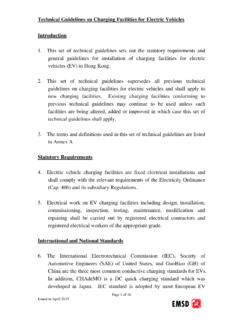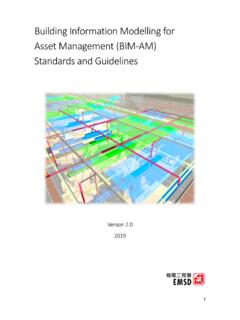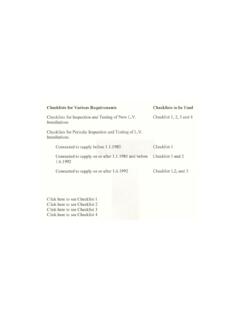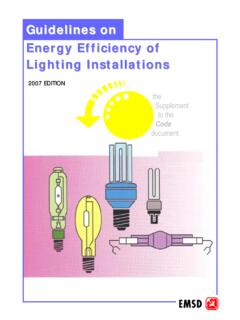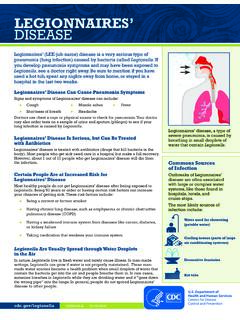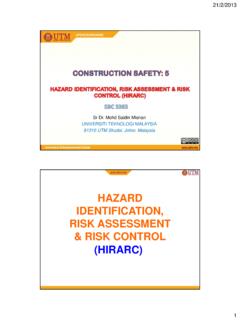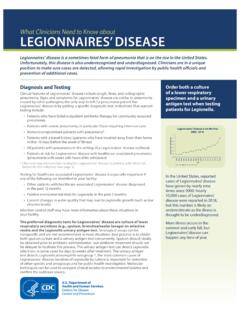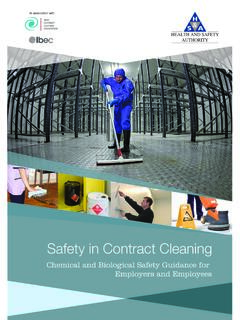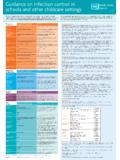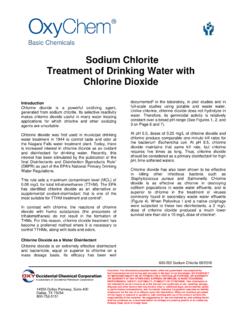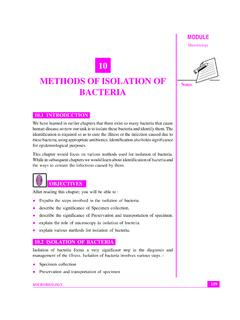Transcription of CODE OF PRACTICE - EMSD
1 2016 EditionCODE OF PRACTICEFORFRESH WATER COOLING TOWERSPART 1: DESIGN, INSTALLATION AND COMMISSIONING 2016 EDITION(DEC 2016)Electrical and Mechanical Services DepartmentThe Government of the Hong Kong Special Administrative RegioniCode of PRACTICE for Fresh Water Cooling TowersPart 1: Design, Installation and Commissioning2016 EditioniiCode of PRACTICE for Fresh Water Cooling TowersPart 1: Design, Installation and CommissioningThis code of PRACTICE was prepared to promote the proper use of fresh water cooling towers with guidelines for cooling tower design, installation, testing, commissioning, operation and maintenance in order to meet the energy efficiency objective with due consideration of the environment and health issues. It was developed by the Task Force on code of PRACTICE for Fresh Water Cooling 1 of this series of code of PRACTICE for Fresh Water Cooling Towers (previously known as code of PRACTICE for Water-cooled Air Conditioning Systems) provides details on the design, installation and commissioning of cooling towers.
2 It should be read in conjunction and made cross-reference with the followings:Part 2 Operation and Maintenance; andPart 3 Water Treatment EditioniiiCode of PRACTICE for Fresh Water Cooling TowersPart 1: Design, Installation and Tower Types and Cooling Tower Tower Tower Tower Construction and Installation Tower and Fan Distribution Circulation Sampling Abatement Tower and Tower Supporting Tower Installed Location162016 EditionivCode of PRACTICE for Fresh Water Cooling TowersPart 1: Design, Installation and Towers installed on Building Towers installed on Podium Roof Towers installed indoors with Vertical Discharge through Roof or Horizontal Discharge through Side Towers installed at Other Separation between Cooling Separation from Physical Location at a Composite Building (Residential and Commercial)
3 Location not fulfilling the Required Minimum Tower Water and Bleed-off Water Water Quality Control and Reuse of Bleed-off and Management of a Cooling Tower Management Plan and Commissioning of Cooling Tower and Safety and and Commissioning of a System Information29 AppendicesAppendix 1A Typical Schematic Diagram of Fresh Water Cooling Towers Condensing Water Circuit30 Appendix 1B Guidance Notes on Minimum Separation Requirements for Cooling Towers31 Appendix 1C Samples of Notices and Labels for Cooling Tower System38 Appendix 1D A Standard Risk Management Plan for Fresh Water Cooling Tower System39 Appendix 1E A Sample Checklist for Minimum Testing and Commissioning Procedures of Fresh Water Cooling Tower System42 Appendix 1F A Recommended List of Personal Protective Equipment442016 EditionvCode of PRACTICE for Fresh Water Cooling TowersPart 1: Design, Installation and CommissioningBiocide:A physical or chemical agent that kills bacteria and other :A chemical compound added to the water inside cooling tower system, to penetrate and break down any biofilm that may be present on the wetted surfaces of the cooling tower :A surface layer of microorganisms.
4 It is usually combined with particulate matter, scale and products of off (blowdown):The removal of water from a cooling tower system to maintain the concentration of total dissolved solids and suspended solids in an acceptable :A systematic and progressive process of putting the components of a system into operation, calibrating instruments and controls, and then making adjustments and checks to ensure that the total system is providing satisfactory operation and tower:A device for lowering the temperature of water by evaporative cooling in which ambient air is in contact with falling water, thereby exchanging heat. The term also includes those devices that incorporate a water-refrigerant or water-water heat exchanger (evaporative condenser or closed-circuit cooling tower).
5 Cooling tower system:A heat exchange system comprising a heat-generating plant (chiller condenser or heat exchanger), a heat-rejection plant (cooling tower or evaporative condenser) and interconnecting water recirculating pipework and associated pumps, valves and controls. Corrosion coupon:Small strip of metal, usually placed into water circuits so that they can easily be removed, to enable the corrosion characteristics of the water to be EditionviCode of PRACTICE for Fresh Water Cooling TowersPart 1: Design, Installation and CommissioningCorrosion inhibitor:Chemical which protects metals by: (a) passivating the metal by the promotion of a thin metal oxide film (anodic inhibitors); or (b) physically forming a thin barrier film by controlled deposition (cathodic inhibitors).Cycle of concentration:The ratio between the concentration of dissolved solids in the cooling water and the concentration of dissolved solids in the make-up water as a result of the evaporation that takes place in the cooling towerDead leg:Water pipe with length equal to or larger than one diameter of the pipe, ending at a fitting through which water flows only when the fitting is opened.
6 These extra areas of the cooling tower system contain stagnant water, which can cause building up of bacteria and sludge in recirculating system, and can then contaminate the system. Decontamination:A process used when a cooling tower system is found with a level of bacterial count which involves a series of actions to disinfect, clean and re-disinfect the cooling tower system. Disinfection:Preventive maintenance action of applying a treatment to a system, in conjunction with system cleaning, in order to reduce the general concentration of infectious :Reagent usually added with other treatment chemicals to prevent accumulation of eliminator:A grid or grille-like arrangement of physical barriers located before the cooling tower exhaust designed to minimise the drift emanating from a :Water lost from the cooling tower as liquid droplets or aerosols entrained in the exhaust air, excluding EditionviiCode of PRACTICE for Fresh Water Cooling TowersPart 1: Design, Installation and CommissioningExhaust air outlet:A termination of a mechanical or natural ventilation system that allows air removed from a space and discharged outside the building.
7 The exhaust air outlets, which are crucial in the consideration of separation distance with the cooling tower, are exhausts from kitchens, toilets, emergency generator (flue gas), carpark ventilation, fume cupboard and refuse collection room, and any exhaust that contains contaminants or nutrients for microbial growth in cooling :A rotary machine which propels air continuously. This is used for moving air in a mechanical draft tower. The fan may be of induced draft or forced draft (packing):Material placed within cooling tower to increase heat and mass transfer between the circulating water and the air flowing through the :The process of separating solids from a liquid by means of a porous substance through which only the liquid :Organic growth or other deposits on heat transfer surfaces causing loss in colony count (HCC):The number of viable units of bacteria per millilitre of water sample.
8 It is also known as Total bacteria Count (TBC), Total Plate Count or Viable bacteria disease:It is a type of bacterial pneumonia caused by and health care premises:Hospitals, general clinics, specialist clinics; community support facilities for the elderly, such as residential elderly homes, social centre for the elderly; and establishments providing health care and services for the sick and biocide:A non-oxidising biocide is one that functions by mechanisms other than oxidation, including interference with cell metabolism and EditionviiiCode of PRACTICE for Fresh Water Cooling TowersPart 1: Design, Installation and CommissioningOperable window:An operable window is a window that has moving parts, such as hinges, and can be opened. If a window is permanently locked or required special tools to be opened, that window would not be considered as an operable window when examining the separation air intake:A termination of a mechanical or natural ventilation system that allows ambient air entering a building.
9 The outdoor air intakes, which are crucial in the consideration of separation distance with the cooling tower, are fresh air intake for the air conditioning system of a building, and any air intake that draws outdoor air into the biocide:Agents capable of oxidising organic matter, cell material enzymes or proteins which are associated with microbiological populations resulting in death of the micro-organisms. Passivation:The formation of a protective film, visible or invisible, which controls :The visible discharge of air and moisture from a cooling tower due to condensation. It is usually most visible in cool and humid days when water vapour emanates from the cooling tower accessible area:An area that is accessible by the public or building occupants other than building management/maintenance staff.
10 Some of the examples are pedestrian thoroughfare/ footpath, place where people gather together for activities, accessible green roof/garden. Restricted area with proper access control which is only accessible by building management/maintenance staff is not considered as a public accessible Roof:Roof of the lower part of a building. Scale:A crystalline deposit that can form on surfaces or pipework within the cooling tower system due to building up of minerals (usually calcium carbonate).2016 EditionixCode of PRACTICE for Fresh Water Cooling TowersPart 1: Design, Installation and CommissioningScale inhibitor:Chemicals used to control scale. They function by holding up the precipitation process and/or distorting the crystal shape, thus preventing the build-up of a hard adherent :A building up of sediment that can be found in the basin or pipework of a cooling tower dosing/Shock dosing:The process of adding in a single dose a much higher amount of chemical biocide than is normally applied, with the intention of rapidly raising the concentration of biocide in the water to a level expected to kill most of the organisms in the nozzle:A device used in an open distribution system to break up the flow of the circulating water into droplets, and effect uniform spreading of the water over the wetted area of the water.


